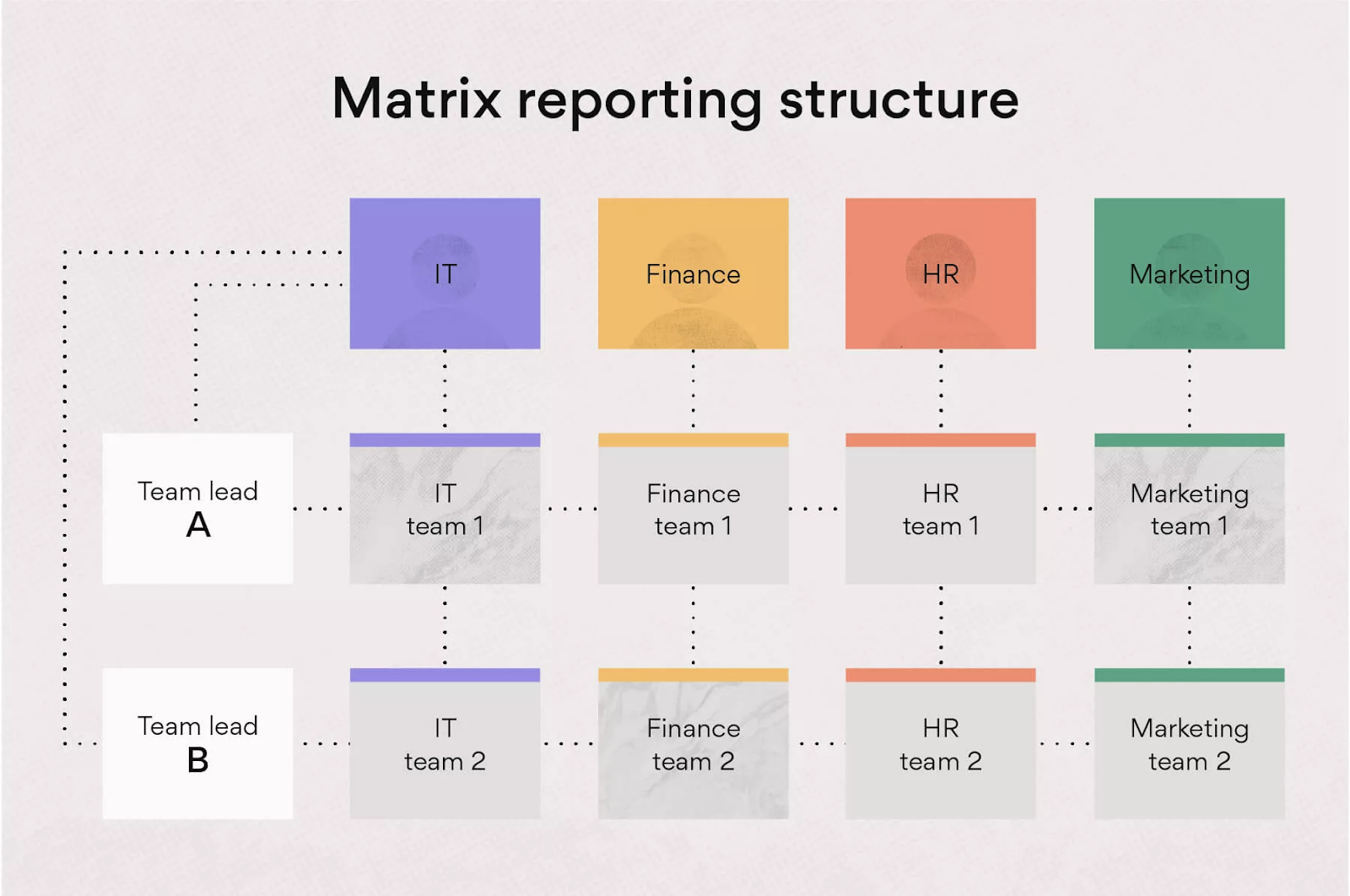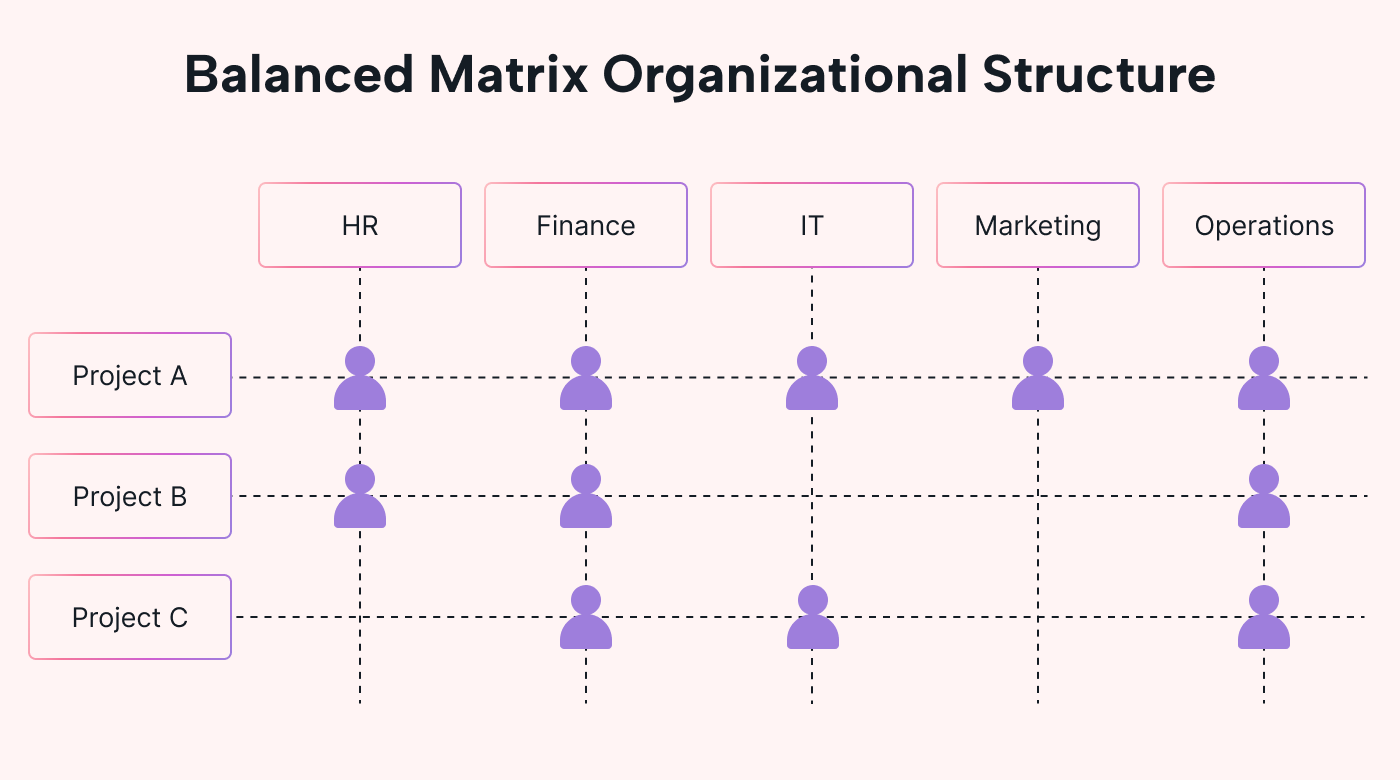A matrix organization employs a distinctive management structure that blends traditional hierarchical systems with a functional approach.
In this hybrid setup, each employee typically reports to two managers: a functional manager, who offers technical guidance, and a project or department manager, who oversees operations or project-specific progress. This dual-managerial system fosters the creation of cross-functional teams, enhancing collaboration and knowledge sharing across departments.
However, it can also present challenges, such as unclear roles and responsibilities, complex chains of command, and ambiguities in decision-making authority. The effectiveness of matrix management depends largely on its proper implementation, with a clear understanding of both divisional and product structuring.
Introduction to matrix organization
A matrix organization integrates elements of both functional and divisional structuring, creating a unique management environment.
Employees have multiple reporting lines, typically to a functional manager and a project or department manager. This structure allows the formation of cross-functional teams, facilitating the sharing of resources and enhancing communication among different departments.
Matrix management enables a blend of product and functional structures, which supports collaboration and ensures that specialized skills are utilized effectively. The organization’s key characteristics include well-defined roles, complex chains of command, and shared decision-making authority, moving beyond the simplicity of a traditional hierarchical agency organizational chart.

Definition of matrix organization
A matrix organization is a hybrid structure that merges functional and divisional elements. It organizes employees into cross-functional teams led by project managers, breaking away from the conventional single-line reporting seen in hierarchical organizational charts. This dual authority system grants decision-making powers to both functional and divisional managers, facilitating a more dynamic allocation of resources and responsibilities.
The matrix setup allows for clear yet flexible roles, promoting efficiency and adaptability in managing projects and organizational tasks.
History and evolution of matrix organization
The concept of matrix organization emerged in the aerospace industry during the 1960s. This management structure was designed to allow employees to be managed by multiple supervisors—a functional manager to lead their specific discipline, and a project or divisional manager to guide their project involvement.
The dual reporting relationships in matrix organizations facilitated the creation of cross-functional teams, enhancing collaboration and communication across functional groups. This shift altered traditional chains of command and decision-making authority, as typically depicted in hierarchical organizational charts, leading to improved efficiency in complex and large-scale projects.
Over time, matrix management evolved as a strategic response to increasing business complexities, enabling organizations to manage multifaceted tasks effectively and enhance productivity.
How to use Bonsai for advanced matrix organization
Using Bonsai for an advanced matrix organization can significantly enhance efficiency and collaboration across multiple projects and teams. In a matrix organization, employees report to multiple managers, typically both a functional manager and a project manager. This structure can be complex, but Bonsai’s powerful features make it manageable.
- Bonsai’s project management capabilities allow for the creation of multiple projects with distinct tasks and milestones.
- Each project can be assigned to different teams or individuals, ensuring clear accountability.
- The tool’s user-friendly interface makes it easy to navigate between projects, providing a comprehensive overview of all ongoing activities.
Bonsai’s task management features are particularly beneficial in a matrix setup. Tasks can be assigned to individuals across different functional areas, with detailed descriptions, deadlines, and priority levels. This ensures that everyone knows their responsibilities and can manage their workload effectively. The ability to attach files and add comments to tasks facilitates seamless communication and collaboration, reducing the risk of misunderstandings.

Moreover, Bonsai’s real-time updates and notifications keep all team members informed about changes and progress, which is important in a matrix organization where coordination is key. The tool’s dashboards and reporting features provide valuable insights into project status, resource allocation, and potential bottlenecks. This transparency helps managers make informed decisions and adjust plans as needed to keep projects on track.

Bonsai also supports integration with other tools commonly used in matrix organizations, such as QuickBooks, Zapier, and Xero. This ensures that teams can continue using their preferred tools while benefiting from Bonsai’s advanced project management capabilities.
In conclusion, Bonsai is an invaluable tool for managing the complexities of an advanced matrix organization. Its features enhance task management, communication, and transparency, enabling teams to collaborate effectively and achieve their goals. By using Bonsai, matrix organizations can streamline their processes, improve efficiency, and drive successful project outcomes.
Key features of a matrix organization
Matrix organizations are characterized by a blend of vertical (functional) and horizontal (divisional) chains of command. This dual structure allows employees to work collaboratively across departments, forming cross-functional teams under the leadership of project or department managers.
Key roles include functional managers, project managers, and divisional managers, each with specific responsibilities and shared decision-making authority. This setup moves away from the rigid structure of traditional hierarchical charts, combining product structuring with divisional structuring to optimize resource use and enhance communication.
Structure of a matrix organization
The structure of a matrix organization typically includes both functional and project-based management elements. This configuration integrates various functional groups, such as marketing or finance, with project-oriented teams, all reporting to common managers.
By combining expertise from different areas, matrix management facilitates collaboration towards shared goals or objectives. In this setup, functional managers hold vertical decision-making authority within their specialties, while project managers exercise horizontal authority across teams.
Divisional managers balance these chains of command, ensuring smooth operations and alignment with overall organizational goals. This structure is often visualized in a hierarchical organizational chart, depicting the dual reporting lines that define the matrix organization.
Roles and responsibilities in a matrix organization
Matrix organizations combine traditional hierarchical models with project-focused approaches, creating a complex management structure with both vertical and horizontal chains of command.
Roles and responsibilities are divided among key positions: divisional managers oversee departmental structuring, functional managers lead specific functional groups, and project managers coordinate cross-functional teams for project-based tasks. This setup enriches employees' roles by promoting flexibility and information sharing.
However, it requires clear role definitions and effective communication to prevent confusion and conflicts within this multi-dimensional structure.
Benefits of implementing a matrix organization
Implementing a matrix organization brings together the strengths of functional and divisional structuring, enhancing decision-making authority and fostering cross-functional teamwork. This management structure breaks down silos often seen in traditional hierarchical charts, facilitating efficient communication and collaboration across departments.
It empowers managers at different levels—divisional, functional, and project—to make decisions pertinent to their areas of expertise. This shared knowledge environment encourages continuous learning and process innovation, optimizing resource use and supporting flexible product structuring.
Increased collaboration and communication

In a matrix organization, collaboration and communication are key to successful operations. The cross-functional team structure promotes direct interaction between different departments, reducing gaps and enhancing teamwork.
The involvement of project managers in direct communication with teams strengthens decision-making authority and ensures that all team members understand their roles and responsibilities within the organizational hierarchy. This approach leads to higher productivity and more effective project outcomes.
Efficient use of resources
Matrix organizations excel in the efficient allocation and use of resources. By strategically organizing roles such as project managers, functional managers, and divisional managers, these organizations can deploy resources effectively.
The structure enables the formation of cross-functional teams, promoting collective decision-making and improved communication. This approach minimizes the limitations of traditional hierarchical charts, facilitating better resource utilization and ensuring that expertise is applied where it is most needed.
Flexibility and adaptability
The flexibility and adaptability of matrix organizations are among their greatest strengths. This management structure allows for quick adjustments between different organizational needs, such as shifting from product structuring to functional grouping, optimizing decision-making authority, and maximizing efficiency.
By fostering a culture of collaboration, matrix management encourages employees to develop a broad skill set and engage in teamwork. Roles can be reassigned as needed, ensuring that critical tasks are managed by capable individuals, thus maintaining productivity and competitiveness in a dynamic business environment.
Challenges in a matrix organization
Matrix management, while offering flexibility and enhanced collaboration, also brings several challenges. One significant issue in this organizational structure is the dual reporting lines, where employees report to multiple managers—functional, project, or divisional. This can lead to confusion about roles and responsibilities, as conflicting interests between these managers may arise, complicating decision-making authority.
The complexity of accommodating employees in both functional groups and cross-functional teams can make the management structure difficult to navigate.
Additionally, defining clear chains of command is challenging, as the hierarchical organizational chart may not always clearly depict the multifaceted relationships. This complexity can complicate product and divisional structuring, leading to inefficiencies.
Complexity and confusion
The intricate nature of a matrix organization often breeds confusion. With overlapping roles and responsibilities between functional managers and project managers, the lines of authority can become blurred.
The traditional hierarchical organizational chart may not clearly represent these relationships, making it difficult to understand who holds decision-making power. In cross-functional teams, where various managers and team members collaborate, deciphering the chain of command can be especially confusing.
To avoid misunderstandings, it is essential to maintain clarity in both divisional structuring and product structuring, ensuring that management operations run smoothly.
Conflict and power struggles
Conflict and power struggles are common in any complex organizational structure, and matrix management is no exception.
The overlapping roles of functional managers, project managers, and department managers can lead to friction, particularly when there are differing perspectives on priorities and decision-making authority. In a matrix system, conflicts can arise within functional groups, where individuals may vie for influence, or between different groups, especially in cross-functional teams.
Without clear divisional structuring and a balanced approach to product structuring, these power struggles can escalate, creating ambiguity in leadership and impeding decision-making. Unresolved conflicts can disrupt the hierarchical organizational chart, diminishing productivity and morale.

How to effectively manage a matrix organization
Effective management of a matrix organization requires careful balancing of divisional and functional structuring. This involves assigning employees to both a functional manager and a project or department manager, creating dynamic and responsive teams.
Key to managing this complexity is establishing clear chains of command and defining decision-making authority. Visual tools like a hierarchical organizational chart can help illustrate these relationships.
Here are key strategies for managing a matrix organization effectively:
- Clear communication of responsibilities and tasks: Define each manager’s and team member’s roles to avoid overlap and confusion.
- Understanding the unique strengths of each functional group: Recognize and leverage the specific skills and expertise within each group.
- Fostering a collaborative culture: Encourage open communication and teamwork across different departments and functions.
Clear definition of roles and responsibilities
In a matrix organization, clearly defining roles and responsibilities is crucial to avoid confusion and ensure efficient operations. This involves specifying the duties and decision-making authority of each individual within the organizational structure, often visualized through a hierarchical organizational chart.
Key roles include:
- Project Manager: Leads cross-functional teams and coordinates project-specific tasks.
- Functional Manager: Oversees a specific functional group and manages daily operations within that area.
- Divisional Manager: Manages broader divisional structuring, ensuring alignment with overall organizational goals.
Effective communication strategies
Effective communication is vital in a matrix organization to maintain a cohesive working environment.
Strategies include:
- Clarifying chains of command: Ensure that employees understand which manager to approach for different issues, whether it’s a department or divisional manager.
- Promoting cross-functional teams: Encourage collaboration between different functional groups to bridge communication gaps and improve coordination.
- Utilizing organizational charts: Use hierarchical organizational charts to help employees understand the structure of product or divisional groups, making it easier to identify the appropriate points of contact.
Conflict resolution techniques
In matrix organizations, conflict resolution is essential to maintaining a productive and positive work environment.
Techniques include:
- Promoting open communication: Encourage team members to voice concerns and discuss issues openly, preventing conflicts from escalating.
- Establishing clear roles and responsibilities: Define the duties of each role within the management structure to minimize overlap and ambiguity.
- Empowering decision-makers: Ensure that project managers, department managers, and divisional managers have clear decision-making authority to resolve disputes efficiently.
Real-world examples of matrix organizations
Matrix organizations are like the multitool of the corporate world, designed to handle multiple tasks simultaneously. Think about Philips, a heavyweight in diversified technology. They’ve mastered the art of balancing functional and divisional responsibilities.
How? By having functional managers steer centralized teams, while divisional managers drive product- or project-specific teams.
Now, take Procter & Gamble (P&G), a giant in consumer goods. They weave their matrix structure to combine product-centric and geographical divisions. Here, cross-functional teams become the backbone of productivity.
Each division operates like its own mini-company, yet collaboration is key. Decisions? Made jointly, ensuring everyone’s on the same page. This kind of structure isn’t just about keeping things in order; it’s about optimizing the chain of command and making decision-making a breeze.
Matrix organization in Philips
At Philips, the matrix structure is more than just lines on an organizational chart; it’s a blueprint for innovation and efficiency. Here, employees report to two managers. Imagine that—two bosses!
One is a functional manager who focuses on your everyday work activities, while the other is a project manager coordinating cross-functional teams. This dual reporting structure is like having two eyes—one focused on the task, the other on the bigger picture.
This setup allows for resource sharing, adaptability, and a problem-solving mindset across various functional groups. But there’s a catch: the complexity can sometimes blur lines of authority.
Who’s really in charge? That’s where clear communication and role definition come into play.
Matrix organization in Unilever
Unilever’s approach to matrix management merges the best of both worlds—functional and divisional. Cross-functional teams take center stage, with project managers holding the reins of decision-making. Divisional and functional managers share the responsibilities, driving the chains of command.
Roles are clearly mapped out, thanks to a hierarchical organizational chart. This structure doesn’t just offer flexibility; it’s designed for agility. Unilever can pivot and adapt to market changes faster than you can say “new product launch.”
Tools and software for managing a matrix organization
Navigating the complex waters of a matrix organization requires the right tools. Think of them as the compass and map for your voyage. These tools help define roles and responsibilities, ensuring everyone knows who’s steering the ship. With features that support divisional and product structuring, as well as hierarchical organizational charts, software solutions make managing a matrix setup a piece of cake.
Bonsai for project organization
Bonsai is an exceptional tool for project organization, designed to streamline and enhance the management of tasks and workflows. The platform allows teams to set up projects effortlessly, creating a clear structure with defined tasks, deadlines, and priorities. Bonsai’s drag-and-drop functionality makes it easy to adjust plans on the fly, ensuring flexibility and responsiveness to changes.

The tool’s powerful task management features enable detailed task descriptions, attachments, and checklists, ensuring all necessary information is centralized and accessible. Real-time updates and notifications keep team members informed, fostering seamless communication and collaboration. Bonsai’s comprehensive dashboards
Overall, Bonsai enhances project organization by promoting efficiency, transparency, and effective collaboration.
Asana for task management
Asana stands out as a powerhouse for task management in matrix organizations. It’s like having a roadmap for every project. The platform makes it easy to define who’s responsible for what, streamlining the chain of command. Project managers, functional managers, and even department managers can coordinate tasks with precision. Asana’s simple, intuitive layout ensures that tasks don’t get lost in the shuffle. It’s all about clarity and accountability.
Slack for communication
Communication is the glue that holds a matrix organization together, and Slack is the perfect adhesive. Whether it’s for cross-functional teams or divisional managers, Slack streamlines communication. Think of it as a virtual office space where ideas flow, decisions are made, and everyone’s in the loop. It clarifies roles and ensures transparency in the decision-making process. The result? Higher productivity and a team that’s always on the same page.
Conclusion: Is a matrix organization right for your agency?
Wondering if a matrix organization is a good fit for your agency? Think about your need for collaboration and flexibility. Matrix management blends divisional and functional approaches, allowing employees to wear multiple hats. It’s great for fostering innovation and agility. However, beware of potential pitfalls—like unclear authority lines. Make sure to design a structure with a clear organizational chart to avoid confusion.
Before diving into a matrix structure, take a close look at your current setup. Transitioning to a matrix model isn’t just a tweak; it’s a transformation. You’ll need to reassess roles—from project managers to department heads. How will chains of command change? How will decision-making be affected? These are critical questions that will impact the effectiveness of your cross-functional teams.
Ready to make the switch? Start by blending functional and divisional structuring. Form cross-functional teams that report to multiple managers. It’s all about collaboration and knowledge sharing. But remember: clarity is key. Define roles and responsibilities clearly to prevent confusion. A hierarchical organizational chart can serve as a guide, helping everyone understand their place in the matrix. With these steps, you’ll be on your way to a more dynamic and responsive organization.







